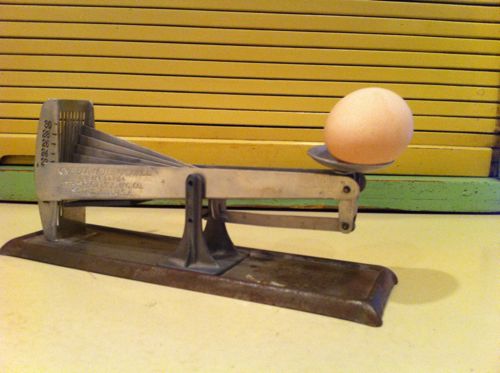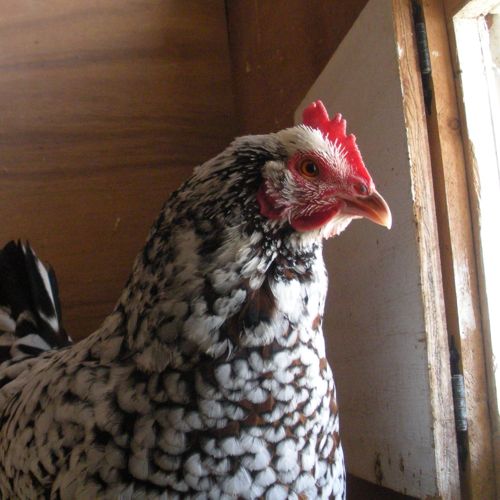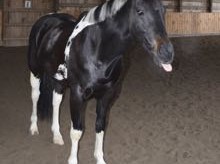Lulu laid an egg!
This is a sure sign of spring.
Lulu is a 4-year old Speckled Sussex. She doesn’t lay during the winter, and she goes broody in the summer. In between, she lays lovely brown eggs, just not very many. This year I’m actually hoping that she’ll go broody, so I can put some of the chicks coming at the end of April under her. Being Lulu, though, she’ll undoubtably do something unexpected.



Lulu is gorgeous!
Pretty hen.
And her English counterpart Bibby laid her first egg of the year today too! She’s only three years old, but I was still surprised…
lulu certainly has her eye on us!
Lulu is a lovely gal. How is her temperament? She reminds me of my Belgian Bearded D’Uccle (except without the beard and muffs!). I’m impressed that she is still laying eggs at the ripe old age of 4!
Will she be a good mother though ?
Thanks, all. Yes, Lulu is very pretty. She’s the “crazy” hen – Speckled Sussex have a reputation for being outgoing and outrageous and she fits that description to a T. She does everything more dramatically than the rest, so I’m hoping that she’ll be a fiercely loyal mother. We’ll see!
Congratulations to Lulu! (She and Buffy are my favorite duo.)
I love watching the hen mamas, but I ended up with 2/5 roos last year, so I will probably buy chicks this year. I had thought I’d get more Orpingtons, but the hay store has Dorkings which are supposed to be nice hens. Chick Days is coming soon and then I’ll have many many many breeds to confuse me:-)
I’ve a friend who loves his dorkings. Sweet birds. I’m getting chicks, not eggs, and will put some under Lulu – if she’s broody. Otherwise, they’ll all be under the heat lamp.
Terry,
Have you thought about providing artificial light to see if you can get Lulu to go broody sooner?
It works on my hens, I have five broody’s know and had to break out the extra thick leather gloves to gather eggs, tired of getting my hand pecked and especially by one hen, she doesn’t just peck she pecks and twists. OUCH!!!
I have 13 chicks coming the 14th of this month and good old gray momma is broody and will take over the broody phase of raising them for me. It sure is easier and less worry. Don’t have to worry about the heat bulb buring out in the middle of night or an electrical storm that takes out the electric for period of time. She also shows them what to eat and where to get a drink so you don’t have to worry about dehydration or the chicks eating the bedding and not the chick starter.
My chicks aren’t coming until the end of April, so I’m hoping I’m going to get some eggs from Lulu before she goes broody!
Hi Terry, could you talk a bit more about the process of putting ‘store-bought’ chicks under a broody hen? I need to get a companion or two for my sole and much-pecked bantam, and I thought maybe I would let her raise her own pals, once she goes broody. I’m assuming she will go broody because that is what bantams are supposed to do. Do you sneak the babies under the hen at night? I can’t figure out how to do that without disturbing the other hens, roosting above her. Any words of advice will be appreciated.
1. make sure the hen has been broody for at least three weeks, this ensures she is ready for chicks, the normal time period for an egg to hatch. I’ve had hens that will take them sooner but I prefer three weeks.
2. The slipping them under her at night is the safest and easiest way to do it. Set up a broody area for the hen and chicks only. Make sure other hens cannot get to the hen and chicks. One,the other hens may peck on the chicks, two, the broody hen will attack the other hens to protect her chicks and nothing is more furious than a broody hen, the chicks can be killed in the fight. I find it best if you can set the hen up in the broody area a day or two before the chicks arrive. I place the hen in the broody area in the dark with a few eggs, this trick works for me 90% of the time.
My old reliable gray momma will take chicks at any time, light or dark so again, the method is hen dependent.
3. Kathy, you say you need a companion for your “much pecked bantam” and that raising chicks will provide those pals. Well, I’m not sure that will happen. Here is why, at some point (again hen dependent) the hen is going to “ween” the chicks. In my experience it will take place at about 6-8 weeks. When she weens them she typically is not “nice” about it. She will peck them when they get close to her and may even flog the chicks if they don’t take the hint. She will not let them roost next to her either and can for several weeks chase the chicks off if they cross the hens “your too close get lost imaginary line”.
Hi Kathy-
I have a friend who has bantams and a few larger hens. She always uses broodies, never a brooder. She waits until it’s nice and warm out, late in the spring, so that it’s easier on everyone. She has a large, fenced yard and although the broody hen has her own hutch, she forages with everyone else. It’s worked out fine for her. You couldn’t do that in a confined space, but she has exactly the right situation for it. I also know people who keep their hens in broody coops, which is what I’ll do at first, more because of the hawk situation than anything else. But, in all cases, the broody hen should have a nest safely out of the way of the other hens. Also, chicks need their own feed – if the protein is too high, like in laying hen pellets, they’ll grow too fast.
This is a balance to weigh eggs? Lulu looks like an ice flakes.
Yes, it’s an old scale that farms used to use to weigh eggs for market.
Wow, what a beautiful chicken. I just love that coloring, gorgeous!
Nice egg – and antique scale.
Lulu really is beautiful. If she goes broody, maybe we’ll see her being a mom in the chick cam. (See? I was paying attention when you mentioned that in an earlier post.) Or maybe the cam will be in the heat lamp area. Either way, I’m looking forward to seeing your new babies!
Thanks, Terry and Ken, for the tips on getting the chicks in with broodies.
I am getting 6 Rhode Island Red/Rhode Island White crosses at the end of April…Apparently they are very docile and lay HUGE brown eggs! Don’t ya love spring? My hyacinth bulbs came up this weekend!
I have two of those crosses. Nice temperament, good foragers and they laid straight through the winter!
YAY….I AM SO HAPPY TO HEAR THIS!
Pretty hen! We used to have a bantam hen with that same “pattern”.